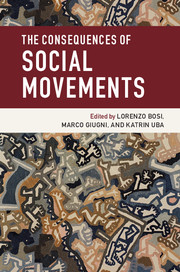Book contents
- Frontmatter
- Contents
- List of figures
- List of tables
- List of contributors
- Introduction
- Part I People
- Part II Policies
- 7 Protest against school closures in Sweden: accepted by politicians?
- 8 Feminist mobilization and the politics of rights
- 9 Reputation, risk, and anti-corporate activism: how social movements influence corporate outcomes
- 10 Tactical competition and movement outcomes on markets: the rise of ethical fashion
- Part III Institutions
- Conclusion
- Index
- References
10 - Tactical competition and movement outcomes on markets: the rise of ethical fashion
from Part II - Policies
Published online by Cambridge University Press: 05 January 2016
- Frontmatter
- Contents
- List of figures
- List of tables
- List of contributors
- Introduction
- Part I People
- Part II Policies
- 7 Protest against school closures in Sweden: accepted by politicians?
- 8 Feminist mobilization and the politics of rights
- 9 Reputation, risk, and anti-corporate activism: how social movements influence corporate outcomes
- 10 Tactical competition and movement outcomes on markets: the rise of ethical fashion
- Part III Institutions
- Conclusion
- Index
- References
Summary
Scholars of social movements have long ignored the consequences of movements on markets. But in the past decade, a number of studies bridging various disciplines started analyzing how movements interact with corporations and provoke market change (de Bakker et al. 2013; King, Chapter 9; Soule and King 2014; Walker 2012). In a review of this burgeoning literature on the “contentiousness of markets,” King and Pearce (2010) distinguish three major approaches through which movements attempt to change markets: contentious actions inside and outside of firms, collaboration, and the developing of new products and categories that constitute new market niches. Many studies have shown how the “success” – i.e., the resulting market change – of given tactics is mediated by contextual conditions (King 2008) and depends on processes involving different actors – movements, firms, states, and other relevant players – trying to shape new markets (Bartley 2007; Weber et al. 2008, 2009).
But while it is possible to assess the outcomes of different tactical approaches individually, they are actually related to one another. Movement organizations are part of “multi-organizational fields” (Curtis and Zurcher 1973) or social movement arenas (Jasper 2011). They pursue similar goals, but use different tactical approaches depending on their social and organizational identities and “cultures of action” (Klawiter 2008). In a dynamic process involving different movement players and their targets, the consequences of one approach may then become an important factor in the contextual “conditions of success” for another one. Focusing on one or the other of these tactical approaches, most studies do not explicitly address this interplay in the transformation of a given market. This is also more generally the case in studies on movement outcomes in the political arena. From an empirical point of view, however, different movement actors very often pursue different approaches concomitantly, and they may be in a competitive or even conflicting relationship. Different tactics such as those of radical and reform-oriented organizations may be complementary and reinforce each other's outcomes, but they may also clash and provoke disputes between movement actors. Given the frequency of such conflicts, studies on movement outcomes have paid surprisingly little attention to their role in achieving change.
This chapter addresses this issue of tactical competition and its role for movement outcomes. How does the interplay of different tactics used by different movement players shape market change such as the emergence of niches?
- Type
- Chapter
- Information
- The Consequences of Social Movements , pp. 237 - 260Publisher: Cambridge University PressPrint publication year: 2016
References
- 7
- Cited by



